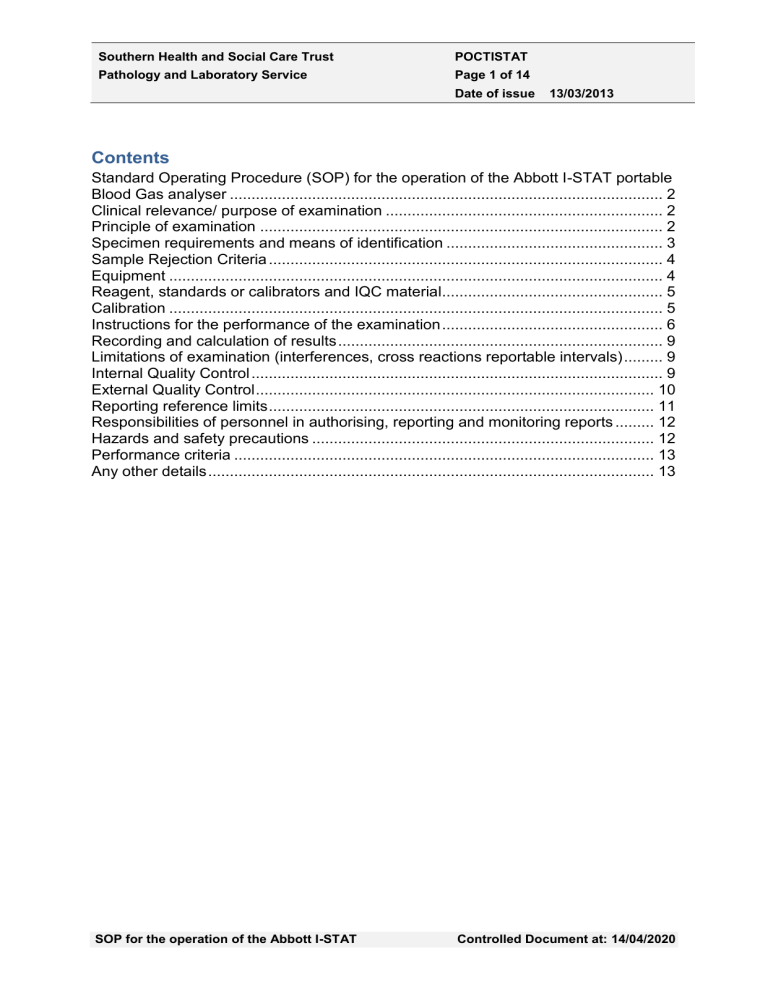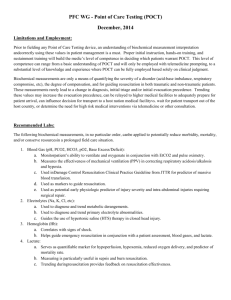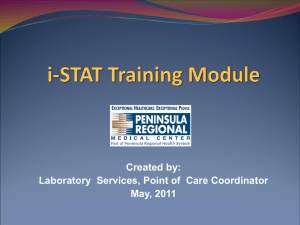i-STAT SOP

Southern Health and Social Care Trust
Pathology and Laboratory Service
POCTISTAT
Page 1 of 14
Date of issue 13/03/2013
Contents
Standard Operating Procedure (SOP) for the operation of the Abbott I-STAT portable
Limitations of examination (interferences, cross reactions reportable intervals) ......... 9
Responsibilities of personnel in authorising, reporting and monitoring reports ......... 12
SOP for the operation of the Abbott I-STAT Controlled Document at: 14/04/2020
Southern Health and Social Care Trust
Pathology and Laboratory Service
POCTISTAT
Page 2 of 14
Date of issue 13/03/2013
Standard Operating Procedure (SOP) for the operation of the
Abbott I-STAT portable Blood Gas analyser
This SOP has been compiled by the POCT committee to provide a template compatible with Clinical Pathology Accreditation standards, containing information users need to achieve consistently reliable and accurate results. This SOP should be read in conjunction with the manufacturer’s manual and strip insert which are available on the trust intranet site.
Clinical relevance/ purpose of examination
The analysis of blood pH and the partial pressure of blood gases (oxygen and carbon dioxide) is an integral part of the management of many patients in a modern acute hospital.
PH is an indicator of the balance between the buffer (blood), renal (kidney) and respiratory (lung) systems. Abnormal pH values are found in metabolic acidosis/alkalosis and respiratory acidosis/alkalosis.
PCO2 assess how well the body eliminates CO2 in relation to rate of CO2 production. A low PCO2 is found in respiratory alkalosis and is usually due to hyperventilation. A PCO2 above the normal range is found in respiratory acidosis and can result from cardiac arrest, COPD, drug overdose or chronic metabolic acidbase disturbances.
PO2 indicates arterial oxygenation status. Low PO2 is caused by pulmonary, circulatory and respiratory abnormalities.
A combination of all three gives a very valuable insight into the acid base balance and efficiency of renal and respiratory function. Adequate tissue oxygenation is vital for all cell respiratory functions and this is reflected in PO2 levels: low levels in properly taken arterial samples indicate a respiratory problem. Hence the PO2 is of value in monitoring patients with primary or secondary respiratory disease.
The i-STAT System incorporates a comprehensive group of components needed to perform blood analysis at the point of care. A portable handheld analyser, a cartridge with the required tests, and 2-3 drops of blood will allow the caregiver to view quantitative test results for blood gas analysis in approximately two minutes.
Principle of examination
The cartridge contains all components to perform one or more tests including: calibrating solution, sample handling system, sensors and reagents. The analyser
SOP for the operation of the Abbott I-STAT Controlled Document at: 14/04/2020
Southern Health and Social Care Trust
Pathology and Laboratory Service
POCTISTAT
Page 3 of 14
Date of issue 13/03/2013 automatically controls all steps in the testing cycle, which may include: fluid movement, reagent mixing, calibration and thermal control. Quality checks are performed continuously throughout the test cycle.
PO2 is measured amperometrically. The oxygen sensor is similar to a conventional
Clark electrode. Oxygen permeates through a gas permeable membrane from the blood sample into an internal electrolyte solution where it is reduced at the cathode.
The oxygen reduction current is proportional to the dissolved oxygen concentration. pH is measured by direct potentiometry. In the calculation of results for pH, concentration is related to potential through the Nernst equation. Results are reported at 37°C.
PCO2 is measured by direct potentiometry. In the calculation of results for P CO2, concentration is related to potential through the Nernst equation. Results are measured at
37°C when using cartridges that require thermal control and corrected to 37°C when using cartridges that do not require thermal control. As the cartridge includes sensors for both pH and P CO2, bicarbonate (HCO3), total carbon dioxide
(TCO2) and base excess (BE) are calculated.
Log HCO3 = pH + log P CO2
– 7.608
BEecf = HCO3 – 24.8 + 16.2 (pH – 7.4)
BEb = (1 - 0.014*Hb) * [ HCO3 - 24.8 + (1.43 * Hb + 7.7) * (pH - 7.4) ] sO2 is calculated from measured P O2 and pH and from HCO3 calculated from measured P CO2 and pH.
(X3 + 150X) sO2=100 ___________________
X3 + 150X + 23400
Where X = PO2 • 10 to the power of (0.48(pH-7.4)-0.0013(HCO3-25))
Specimen requirements and means of identification
Only fresh whole blood samples are recommended for use with the i-STAT System.
Arterial: heparinised syringe labelled for analytes to be tested and filled to capacity, or syringe with minimum volume of heparin to prevent clotting (10U/mL of blood).
For ionized calcium, use balanced heparin syringes. Mix heparinised syringes by rolling between palms for at least 5 seconds in 2 directions, and then invert the syringe repeatedly for at least 5 seconds. Test for lactate immediately. Samples for pH, PCO2, PO2, TCO3 and ionized calcium should be tested within 10 minutes.
Test for other analytes within 30 minutes.
Avoid drawing air into the syringes for blood gas and ionized calcium tests.
If not tested immediately, remix and discard 2 drops of blood before filling cartridge.
SOP for the operation of the Abbott I-STAT Controlled Document at: 14/04/2020
Southern Health and Social Care Trust
Pathology and Laboratory Service
POCTISTAT
Page 4 of 14
Date of issue 13/03/2013
Do not use iced samples.
Venous: Collection tube with lithium or sodium heparin filled to capacity and mixed by gentle inversion at least 10 times. Test within 10 minutes.
Where a sample has to be transported an analyser in a different area the syringe must contain minimum identifiers
Sample Rejection Criteria
Refer to limitations
Equipment
The i-STAT System consists of:
i-STAT Cartridges
i-STAT Portable Clinical Analyser
Portable Printer
Quality Assurance Materials
Electronic Simulator
Control Solutions
Calibration Verification Set (for cartridges)
Data Management System
i-STAT 1 Downloader
i-STAT 1 Downloader/Recharger
IR Link for Portable Clinical Analyser
Data Manager
Central Data Station (data management software for cartridges)
Data Manager Printer
LIS/HIS Interface Software
SOP for the operation of the Abbott I-STAT Controlled Document at: 14/04/2020
Southern Health and Social Care Trust
Pathology and Laboratory Service
POCTISTAT
Page 5 of 14
Date of issue 13/03/2013
Reagent, standards or calibrators and IQC material
i-STAT G3+ cartridge ref 06F03-01/02 when ordered will be delivered centrally to supplies. Upon receipt of new lot numbers cartridges will be sent from Supplies to the
POCT team for verification. The strips will have QC levels 1, 2 and 3 run on them to ensure they are functioning properly.
Regents/standards/calibrator
Microfabricated thin film electrodes or sensors are assembled in disposable, unit-use cartridges containing:
calibrant solution in cartridges with sensors for blood gases, and haematocrit
sample handling system
waste chamber
an array of miniaturized sensors
conductive pads to make electrical contact with the analyser
heating elements in cartridges requiring thermal control at 37 °C
Store at temperatures between 2 and 8 o C (35-46 o F). Do not use after expiration date on cartridge pouch and box.
Equilibrate a single cartridge for 5 minutes or a box of cartridges for 1 hour at room temperature before opening the pouches.
Store cartridges for 2 weeks at room temperature. Mark the cartridge box or cartridge pouches with the room temperature expiration date. Do not expose to temperatures above 30 o C (86 o F). Do not return cartridges to the refrigerator after room temperature equilibration.
Use cartridge immediately after opening pouch. If pouch has been punctured, the cartridge should not be used.
Cartridges are stable in the fridge until expiry date.
Black print thermal paper 2.25” (5.7 cm) wide by 80’ (25 m) long. Paper grade:
TF50KS-E2C - available from Unitech
IQC material
See I-STAT IQC doc on POCT web site for IQC selection, shelf life and storage
The Electronic simulator must be stored in the black box provided.
Calibration
Each I-STAT disposable cartridge performs automated calibration on insertion into the I-STAT
SOP for the operation of the Abbott I-STAT Controlled Document at: 14/04/2020
Southern Health and Social Care Trust
Pathology and Laboratory Service
POCTISTAT
Page 6 of 14
Date of issue 13/03/2013
Instructions for the performance of the examination
SOP for the operation of the Abbott I-STAT Controlled Document at: 14/04/2020
Southern Health and Social Care Trust
Pathology and Laboratory Service
POCTISTAT
Page 7 of 14
Date of issue 13/03/2013
I-STAT
Press the On/Off key to turn analyser on.
Press 2 for I-STAT Cartridge from the test menu.
Scan or enter operator ID. Repeat if prompted. The laser beam automatically turns off after 3-4 seconds or after the barcode is successfully scanned.
Scan or enter patient ID. Repeat if prompted.
Remove cartridge from pouch.
Handle cartridge by its edges. Avoid touching the contact pads or exerting pressure over centre of cartridge.
Following thorough mixing of the sample, direct syringe tip, pipette tip of capillary tube into the sample well.
Dispense sample until it reaches the fill mark on the cartridge.
Fold the snap cover over the sample well until it snaps into place. Press on round tab, not over sample well.
Insert cartridge into cartridge port.
For ACT and PT/INR cartridges, keep analyser on a level surface with the display facing up during testing.
Select tests to be reported if prompted.
Enter sample type and blood gas parameters on chart page if applicable.
View results on analyser’s display.
The analyser automatically stores up to 5,000 test records.
Enter comment code if prompted.
Remove cartridge after Cartridge Locked message disappears. The analyser is ready for the next test immediately
SOP for the operation of the Abbott I-STAT Controlled Document at: 14/04/2020
Southern Health and Social Care Trust
Pathology and Laboratory Service
POCTISTAT
Page 8 of 14
Date of issue 13/03/2013
Result transmission
Place the analyser in Downloader or Downloader/Recharger.
Do not move analyser until Communication in Progress message disappears.
Printer
Turn on printer if green power light is not on.
Align IR windows of analyser and printer.
Display results.
Press the Print key.
Do not move the analyser or printer until printing is complete.
If printer is not powered from a wall outlet, turn printer off.
SOP for the operation of the Abbott I-STAT Controlled Document at: 14/04/2020
Southern Health and Social Care Trust
Pathology and Laboratory Service
POCTISTAT
Page 9 of 14
Date of issue 13/03/2013
Recording and calculation of results
For connected I-STAT meters (i.e. instrument docked daily in a base station cabled into an IT port) the results, identifiers and reagent details will be transmitted automatically to the laboratory on docking. A record of the result should be made in the patient notes immediately as per local protocols, before removal on the cartridge.
For non-connected I-STAT instruments the results along with the patient and user identifiers must be recorded on POCT log sheet in addition to the patient notes.
Results should be recorded immediately, before the cartridge is removed from instrument.
Limitations of examination (interferences, cross reactions reportable intervals)
Exposure of the sample to air will cause an increase in P O2 when values are below 20 kPa and a decrease in P O2 when values are above 20 kPa
(approximate P O2 of room air).
Exposing the sample to air also allows CO2 to escape which causes P CO2 to decrease and pH to increase and HCO3 and TCO2 to be under-estimated.
Care must also be taken to elimi nate “bubbling” of the sample with a pipette when filling a cartridge to avoid the loss of CO2 in the blood.
Standing anaerobically at room temperature will decrease pH at a rate of 0.03 kPA per hour, will increase P CO2 by approximately 0.5 kPa per hour and will decrease P O2 at a rate of 0.3-0.8 kPA per hour
Do not ice samples before testing
–
P O2 results may be falsely elevated in cold samples. Do not use a cold cartridge – P O2 results may be falsely decreased if the cartridge is cold.
Analyse samples collected in capillary tubes immediately to avoid clotting
(especially in neonates whose blood may clot more quickly).
Venous stasis (prolonged tourniquet application) and forearm exercise may decrease pH due to localized production of lactic acid.
Internal Quality Control
Liquid internal control
From each lot in each shipment of cartridges, analyse multiple levels of I-STAT controls using any verified analyser. This will be performed by POCT team or ward equipment control nurse.
Performing IQC (Electronic Simulation)
IQC (Electronic Simulator) ensures that your system is working properly, that you are doing a test correctly, and the meter is providing accurate and reliable results.
SOP for the operation of the Abbott I-STAT Controlled Document at: 14/04/2020
Southern Health and Social Care Trust
Pathology and Laboratory Service
POCTISTAT
Page 10 of 14
Date of issue 13/03/2013
Quality checks are performed continuously throughout the test cycle. The internal simulator check is initiated, every 24 hours or according to a customized schedule, when a cartridge is inserted into the cartridge port.
The failure of any quality check causes the analyser to halt the test cycle and display a “cause”, an “action” message, and a code. See I-STATCODES available on POCT web site
External simulator Quality control tests must be carried out:
before using your meter for the first time
each day the meter is used for patient tests
when starting a new pack of cartridges strips
If the internal simulator result is FAIL
if you drop the meter
after unexpected results
The external simulator check is performed as follows:
1. Turn the analyser on.
2. Press the Menu key to access the Administrative Menu
3. Press the 3 key for Quality Tests.
4. Press the 4 key for Simulator.
5. Scan or enter Operator ID.
6. Enter the Simulator ID (serial number).
7. Insert the simulator into the cartridge port.
8. View results on analyser’s screen.
9. If PASS is displayed, continue to use the analyser.
10. If FAIL is displayed for the external simulator, reinsert the simulator (If FAIL is displayed a second time, do not use the analyser and contact your POCT team).
11. The Electronic simulator must be stored in the black box provided.
External Quality Control
External quality assurance (EQA) is a program that allows testing sites to assess the quality of their performance by comparing their results with those of other units.
Samples are sent from Welsh External Quality Assurance Scheme (WEQAS) to the
POCT Team on a monthly basis. WEQAS provide aqueous solution that contains an unknown concentration of each of the analytes. The samples will be forwarded to each registered participant by the POCT team. Every meter should be registered on the EQA scheme.
These WEQAS samples should be tested exactly the same way as a sample from a patient. IMPORTANT: For best performance perform test and return results on the same day as receipt.
Apply the sample in a similar manner to the patient sample.
SOP for the operation of the Abbott I-STAT Controlled Document at: 14/04/2020
Southern Health and Social Care Trust
Pathology and Laboratory Service
POCTISTAT
Page 11 of 14
Date of issue 13/03/2013
The return form should be completed, photocopied and returned to the POCT Team.
If using internal mail please allow sufficient time to ensure the contact receives the results prior to the deadline stated on the return form.
When the results are returned to the POCT team and logged on the WEQAS website, the accuracy of your meter can be checked. This then forms part of the audit of the blood gas testing procedure.
Your performance will be communicated to you by the POCT team.
Please note it is good practise to maximise over the yearly EQA cycle the number of users involved in EQA sample analysis. EQA performance can be used as part of the assessment of competency.
Maintenance
Cleaning
The meter should be cleaned regularly
• Always switch the meter off before cleaning.
• Wipe with a slightly moist cloth and mild cleaning agent. Do not let liquid drip into the meter
Decontamination procedure
Wipe external service with alcohol wipes
Please complete the permit to work form available at http://vsrintranet.southerntrust.local/SHSCT/HTML/MD/Equipment.html
Reporting reference limits
Reference range
See Laboratory handbook for arterial reference ranges. Please note venous reference range differ slightly please refer to product manual
Alert critical values
All tests not in keeping with the patient presentation should be verified by sending a venous specimen of blood to the laboratory.
Local protocol in relation to the reporting of critical results should be adhered to.
SOP for the operation of the Abbott I-STAT Controlled Document at: 14/04/2020
Southern Health and Social Care Trust
Pathology and Laboratory Service
POCTISTAT
Page 12 of 14
Date of issue 13/03/2013
Responsibilities of personnel in authorising, reporting and monitoring reports
Following the death of a patient, attributed to the inadequate use of a glucose meter, the DOH issued a hazard notice in 1987. This and a more recent notice (1996) highlights the need for a formal staff training programme for meter use together with a strict quality control programme. Meters should only be used with the approval of the laboratory.
Staff responsibilities are outlined in the Trust POCT policy.
All staff working in a healthcare environment have a responsibility to report any incident that occurs involving POCT devices to the ward manager and POCT coordinator.
Manufacturer will provide the following support
Initial training
The laboratory POCT Team (CAH ext 2660) will provide the following support
Technical support
Audit
Advice on POCT QMS
Supplies
Supply consumables.
Hazards and safety precautions
Refer to COSHH assessment.
Do not open the analyser. The analyser may only be opened by factory or factory authorized service personnel. Opening the analyser may result in exposure to hazardous laser radiation.
Do not look into the laser aperture or point the laser beam at other persons.
Staring into the laser aperture may cause hazardous exposure to radiation
Do not place metal objects on or near the exposed gold charging contacts.
Be sure to install all cables and power supplies so they do not pose a trip hazard. Mount equipment so cables and accessories stay clear of walkways.
The AC power supply adapter plug acts as the disconnect device for the
Downloader and Downloader/Recharger and, therefore, the socket outlet must be installed (or located) near the Downloader or Downloader/Recharger and must be easily accessible.
The analyser may be contaminated with blood from prior use. Whenever handling the analyser, cartridges, and peripherals exercise universal
SOP for the operation of the Abbott I-STAT Controlled Document at: 14/04/2020
Southern Health and Social Care Trust
Pathology and Laboratory Service
POCTISTAT
Page 13 of 14
Date of issue 13/03/2013 precautions to protect yourself from blood-borne pathogens. Universal precautions are those procedures and practices, such as the wearing of gloves and lab coat, designed to protect personnel from blood borne pathogens as well as pathogens from other body substances. These precautions are based on the assumption that blood, body fluids or tissue can contain infectious agents and, therefore, should be treated as a biohazard.
Performance criteria
For a full list of performance parameters see the kit insert and manual which can be found on the POCT section of the laboratory web site.
Uncertainty of measurement mean Standard deviation Uncertainty
The uncertainty is based on the variation of X results obtained for distribution XXX
( March XXX ) of the WEQAS ABG scheme using strip lot XXX for multiple wards and operators.
Comparability with laboratory
On XXXX the ABG result was determined 5 times on a patient
1
2
3
4
5 mean
SD
% bias
Lot number
Any other details
The COSHH assessment, user manual and strip insert can be located on the POCT section of the Pathology web site http://10.142.1.242/cahgt/Depts/Labs/webhb/Default.htm
SOP for the operation of the Abbott I-STAT Controlled Document at: 14/04/2020
Southern Health and Social Care Trust
Pathology and Laboratory Service
POCTISTAT
Page 14 of 14
Date of issue 13/03/2013
SOP for the operation of the Abbott I-STAT Controlled Document at: 14/04/2020







